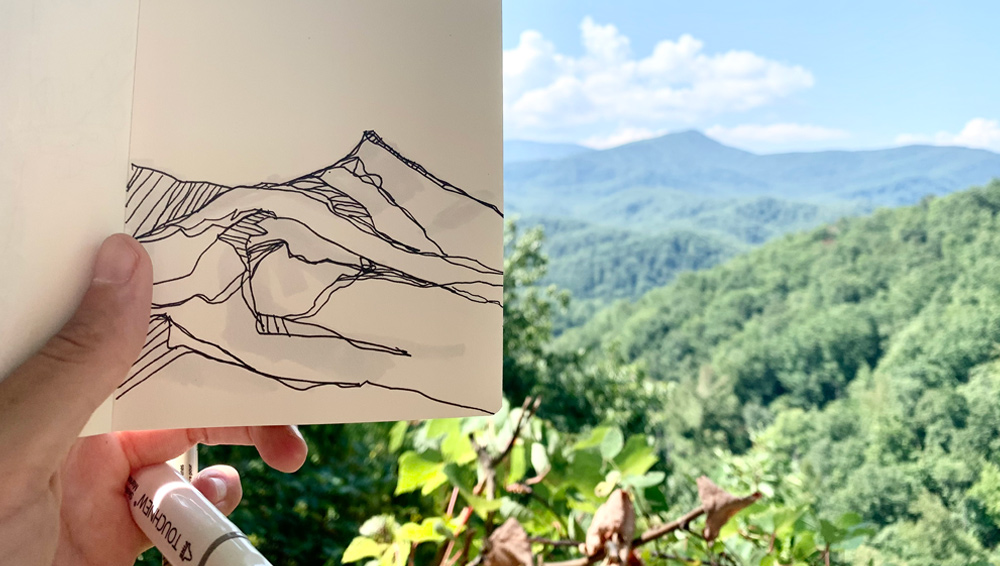The night sky unfolded before us. Orion raised his bow, the little dipper poured into the big. Our crew leader nudged my shoulder; I shifted my gaze in his direction and it was suddenly, incomprehensibly flooded with the incandescent light of the Milky Way. My prior understanding of monumentality, of the endless scope of nature, expanded beyond my wildest imagination. I needed to see more, as much as humanly possible. For the next eight days, each morning started on the overlook as the sun rose over the scaffolded ridges; every night ended with an explosion of stars.
In 2017, I returned to the Smokies, as a member of the ATC’s S.W.E.A.T. Crew. The hiking was more strenuous, the work harder, each day bookended with summits of both Rocky Top and Thunderhead mountains. In the evening, we sat exhausted, sharing dinner and Trail conditions, unpausing conversation with the rotating roster of hikers staying alongside our camp at Spence Field Shelter. There was a pair of 20-something hairdressers traversing the entire park, a father and his two preteen daughters, and a large, overwhelmingly boisterous family who completely filled the shelter. None of them like us, and none of us like each other. There was less stargazing, more storytelling, the passing on of experiences, and a collective sense of how time on these grounds turns those disparate into a community.
After my first visit, I walked away holding the magnitude of these mountains, these trails, inside for myself. I was in awe and filled with a terrific sense of gratitude and personal responsibility towards this park. After the second visit, I left with a profound determination to share this experience with as many people as possible, to continue to grow this mountain community, to prompt others to follow the white blazes of the Appalachian Trail, or any of the 900 miles of trail in the Smokies, to chase the glow of the sunset, to sit in the shadows of the trees. I remained still in awe, now coupled with a determination to foster interest in and a collective ownership of our natural lands, specifically the Great Smoky Mountains National Park (GSMNP).

Although I am formally trained as a draftsman, sitting through hundreds of hours in life drawing courses and studio sessions, in the past few years, my work has been heavily influenced by the concept of deconstructing and depicting narratives through a nontraditional lens. Through a combination of watercolor, ink, and linoleum block print illustrations layered within the construct of a handmade book, traditional narratives can be seen in a new light, while unconventional stories feel familiar and accessible. The inclusion of botanical illustration grounds these narratives in the natural world and provides an element of human connection, depicting the normally shielded structure of parallel internal systems: skin covers muscle as bark encases the heartwood of a birch tree.
The Great Smoky Mountains National Park was the ideal setting to expand my visual vocabulary to the more than 10,000 species of flora and fauna present in a such a lush, vibrant, deciduous forest, as well as learn the narratives of the park itself. Living, and making work, within the boundaries of these thriving natural lands has provided a constant source of inspiration, solitude, and sanctuary. Using a combination of photography, sketchbooks, and journals, I have documented the multitude of species and biologic interactions on daily hikes and overnight trips, pioneering across as much trail in the park as possible.
These sketches and photographs are the basis for a bound book documenting life and change in the mountains, specifically how each species interacts symbiotically or parasitically with another, sparking newness and growth, telling the story of life under the canopy of the forest. Consciously or not, every visitor who steps into the park observes this biological narrative, profoundly influencing the way they themselves subsequently tell the story of the trails, the mountains, this park. My residency has provided the ideal opportunity to speak to park visitors, volunteers, and staff — to hear their own stories and observations, allowing me to weave together the natural narratives with the human one. The completed book consists of unique oversized illustrations and prints that together read as a cohesive text but can also be removed from the binding to stand alone as individual prints.
Through my residency, I hope I brought a preternatural love for these mountains and this breathtaking park to others. Handmade books and journals can take a wide variety of forms; no special paper is needed. A sketchbook can be made from anything that will accept ink or pencil. If used while hiking or camping in the park, they can foster a sense of visitor reflection and encourage visitors to pause, to consider the shapes of leaves, the light coming through the trees, to trace the curves of Clingmans Dome, to note a deer silently observing near Derrick Knob Shelter. For those who have not ventured out, they are an invite to discovery. There’s a power in artistic documentation — a sense of responsibility over its source and for its care. It can promote ownership of our natural lands and empower others to find meaning, to grow, learn, and tell their own stories.